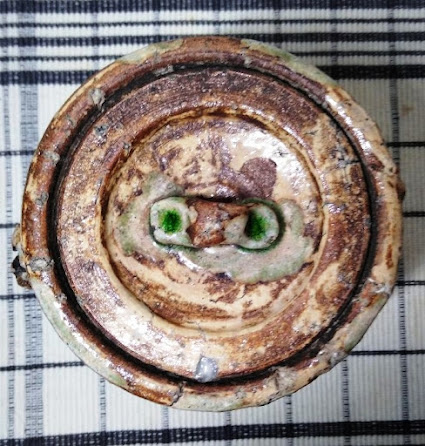216. Iga-ware mizusashi 伊賀焼水指, a lidded fresh water container for the tea ceremony
Dark brown clay, with natural ash glazing in a blue-green color on the exterior and a whitish lining glaze over much of the interior. Weight: 1354 g (3 lbs). Height: 15.1 cm (6 in). Diameter: of mouth, 8.8 cm (3-1/2 in); of lid, 10.4 cm (4-1/8 in), of rim, 12.5 cm (5 in); maximum of body, 13.9 cm (5-1/2 in); of base, 11.6 cm (4-5/8 in).
This sits on the flat base, which has several gouges from the bamboo shaping spatula. Above the base the walls move outward and upward in a straight line at about a 45-degree angle to a height of 1.7 cm (5/8 in) to the meet the walls proper of the body. The widest point of the piece occurs at this junction. The body looks almost as if it had sagged downward at this point. Above the junction the walls move inward in more or less a straight line to a height of about 3 cm (1-1/4 in). From there the walls rise roughly in a straight line to the shoulders of the piece 10 cm (4 in) above the base, where they curve outward and then inward in a convex arc to the neck, which is 10.4 cm (4-1/8 in) in diameter and located 11.4 cm (4-1/2 in) above the base. They then rise in a straight line to the rounded edge of the rim of the piece. The body of the piece is much dented, pitted, grooved. The two ear lugs are affixed at the shoulder; they are crudely fashioned, roughly circular knobs with a hole in the center.
The lid sits on an interior gallery. The bottom of the lid is a rounded convex shape. The edge of the top surface is a flat circle; the interior of this area was hollowed out. A rectangular piece of clay was pressed into the center of the lid and folded upward to create a curved grasping point. The lid sits securely, and all but the top of the grasping point is below the rim of the body proper.
The surface is much pitted and rough to the touch. There are a few small pebbles embedded in the surface of the exterior walls.
The lining glaze covers the bottom of the interior and some of the sides. It is whitish in color. The colors on the exterior range from black through dark browns to a lighter yellowish brown. The yellowish brown color appears to have been brushed on and may result from interaction between the wood-firing and a slip or some sort of flashing glaze. The exterior also has drips and spots of the blue-green ash glaze for which Iga-ware is known. In a few places, this glaze has vitrified and formed the turquoise spots known in Japanese as bidoro (from the Portuguese vitro ‘glass’). The underside of the lid is a sooty black.
This came in an old wooden box. Included in the box was a white wrapping cloth. The top is inscribed 水指古伊賀焼, or “Mizusashi, Old Iga-ware.” The wood has grown so dark over time that the characters are barely visible. At a later point, someone wrote these characters on a small slip of paper and taped it to the lid. The side of the box has an intriguing inscription. The line on the right reads 明治三十一年十一月 (Meiji sanjūichi nen jūichi gatsu). The inscription uses a variant character for the first 十. This translates as “Thirty-first year of the Meiji era, eleventh month,” or November 1896. Japan officially adopted the Gregorian calendar in the 1870s, and I’m assuming this date reflects that.
The middle line of the inscription was written in much larger characters and reads 吉春日. This could have several possible translations. Literally it is “auspicious spring day,” or just “auspicious day.” The first two characters are also used as a given name read “Yoshiharu.” The larger size relative to the other characters indicates its importance. It might be the name of the piece. Interestingly, beneath the second and third characters are the remnants of other characters, impossible to read now.
The third line, on the left, reads 古伊賀水指, or “old Iga mizusashi,’ The inclusion of “old” is intriguing—was the piece already “old” when the box was made? Does the date indicate when the piece was made, or was this a gift on an auspicious occasion with the date of the gifting inscribed on the box?
A great piece of pottery.
Purchased from Treasures of Old Times in Bangkok, Thailand, May 2023.

















No comments:
Post a Comment